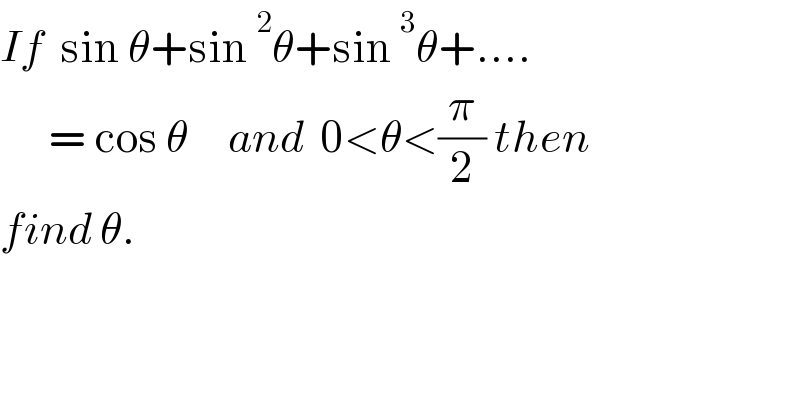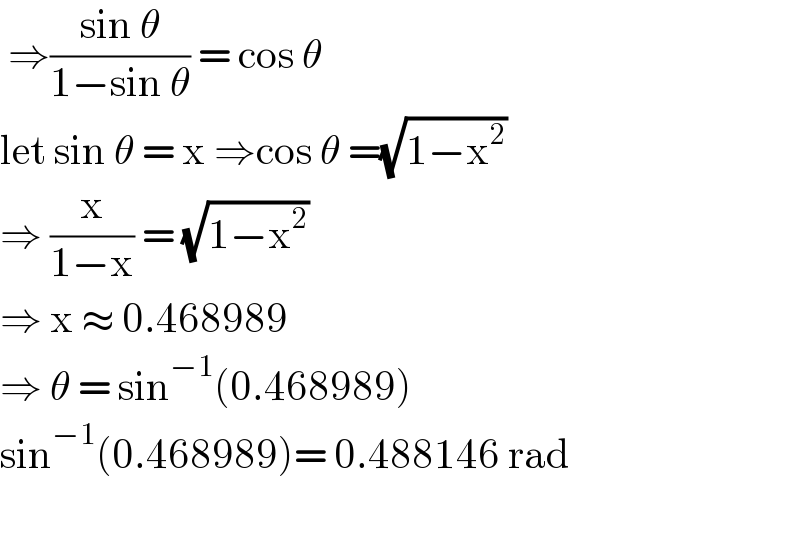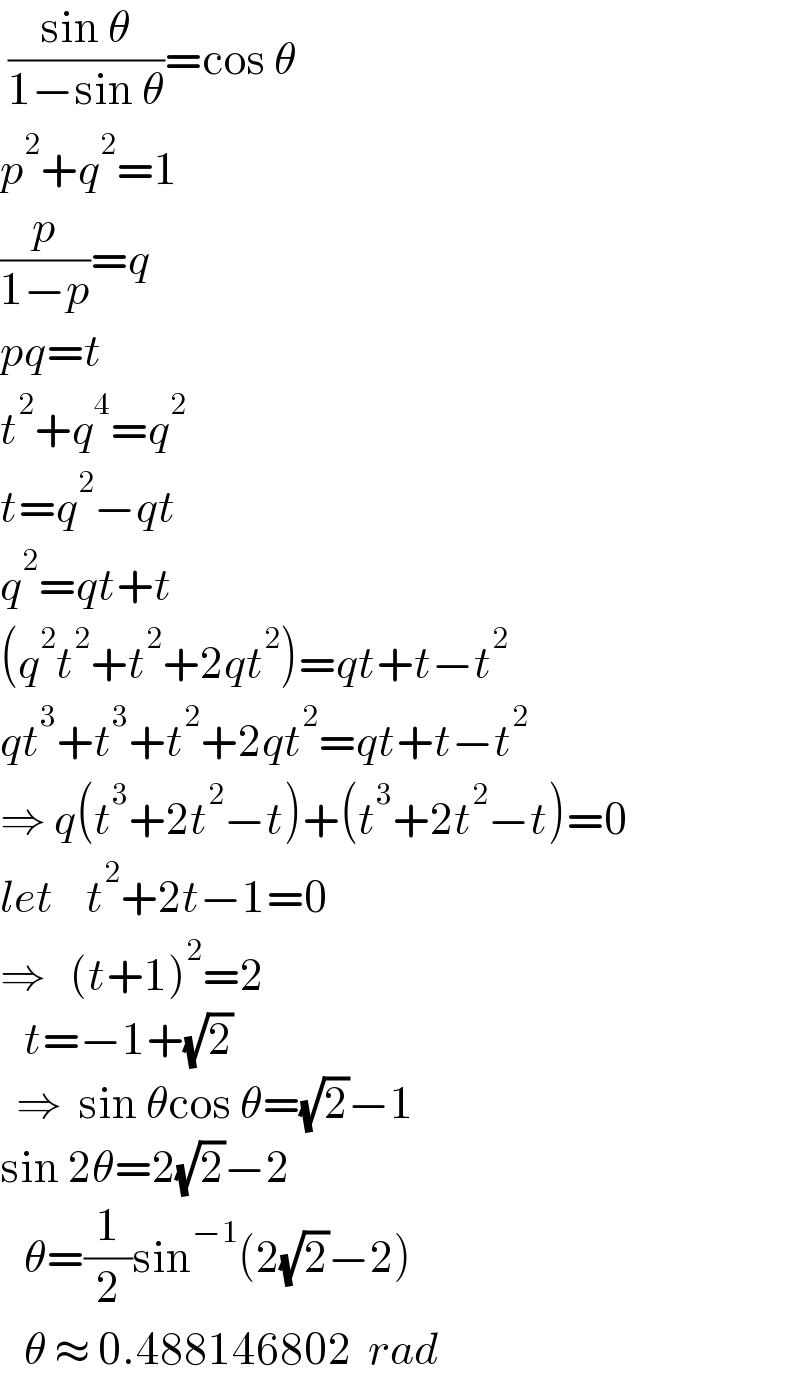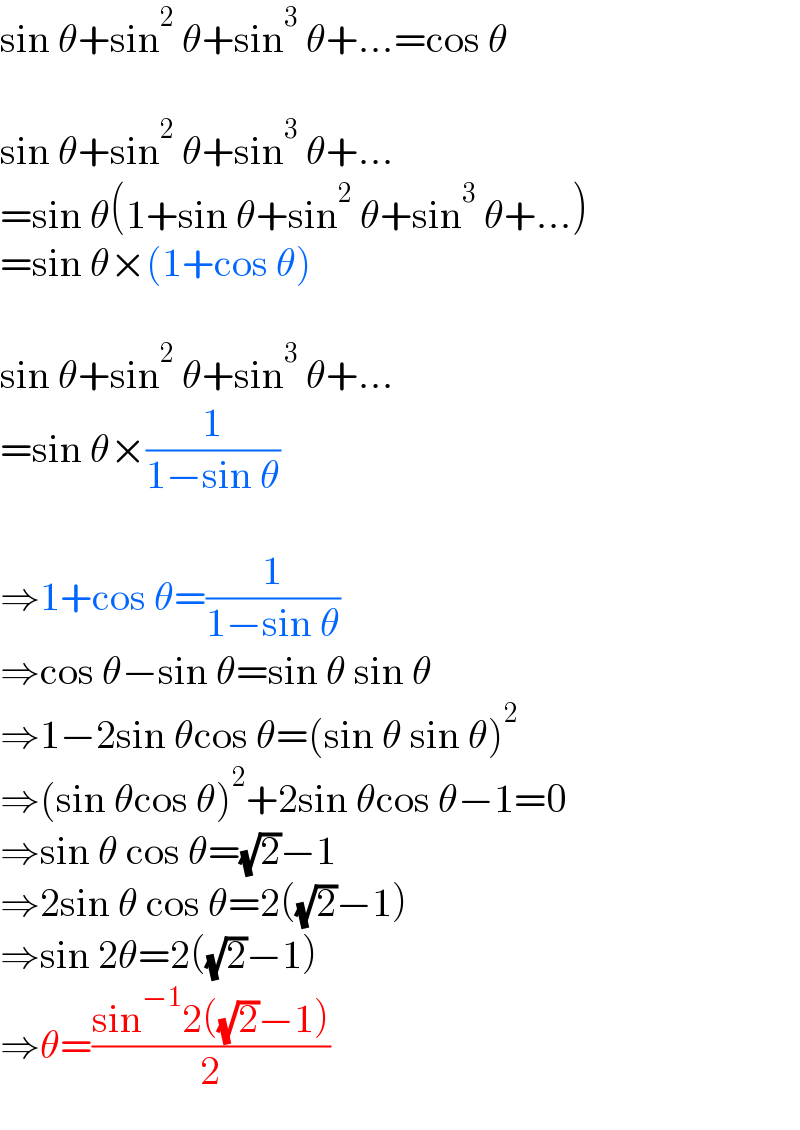
Question Number 140477 by ajfour last updated on 08/May/21

$${If}\:\:\mathrm{sin}\:\theta+\mathrm{sin}\:^{\mathrm{2}} \theta+\mathrm{sin}\:^{\mathrm{3}} \theta+.... \\ $$$$\:\:\:\:\:\:=\:\mathrm{cos}\:\theta\:\:\:\:\:{and}\:\:\mathrm{0}<\theta<\frac{\pi}{\mathrm{2}}\:{then} \\ $$$${find}\:\theta. \\ $$
Answered by benjo_mathlover last updated on 08/May/21

$$\:\Rightarrow\frac{\mathrm{sin}\:\theta}{\mathrm{1}−\mathrm{sin}\:\theta}\:=\:\mathrm{cos}\:\theta \\ $$$$\mathrm{let}\:\mathrm{sin}\:\theta\:=\:\mathrm{x}\:\Rightarrow\mathrm{cos}\:\theta\:=\sqrt{\mathrm{1}−\mathrm{x}^{\mathrm{2}} } \\ $$$$\Rightarrow\:\frac{\mathrm{x}}{\mathrm{1}−\mathrm{x}}\:=\:\sqrt{\mathrm{1}−\mathrm{x}^{\mathrm{2}} } \\ $$$$\Rightarrow\:\mathrm{x}\:\approx\:\mathrm{0}.\mathrm{468989} \\ $$$$\Rightarrow\:\theta\:=\:\mathrm{sin}^{−\mathrm{1}} \left(\mathrm{0}.\mathrm{468989}\right) \\ $$$$\mathrm{sin}^{−\mathrm{1}} \left(\mathrm{0}.\mathrm{468989}\right)=\:\mathrm{0}.\mathrm{488146}\:\mathrm{rad} \\ $$$$ \\ $$
Commented by ajfour last updated on 08/May/21
Thanks sir, i also tried.
Answered by ajfour last updated on 08/May/21

$$\:\frac{\mathrm{sin}\:\theta}{\mathrm{1}−\mathrm{sin}\:\theta}=\mathrm{cos}\:\theta \\ $$$${p}^{\mathrm{2}} +{q}^{\mathrm{2}} =\mathrm{1} \\ $$$$\frac{{p}}{\mathrm{1}−{p}}={q} \\ $$$${pq}={t} \\ $$$${t}^{\mathrm{2}} +{q}^{\mathrm{4}} ={q}^{\mathrm{2}} \\ $$$${t}={q}^{\mathrm{2}} −{qt} \\ $$$${q}^{\mathrm{2}} ={qt}+{t} \\ $$$$\left({q}^{\mathrm{2}} {t}^{\mathrm{2}} +{t}^{\mathrm{2}} +\mathrm{2}{qt}^{\mathrm{2}} \right)={qt}+{t}−{t}^{\mathrm{2}} \\ $$$${qt}^{\mathrm{3}} +{t}^{\mathrm{3}} +{t}^{\mathrm{2}} +\mathrm{2}{qt}^{\mathrm{2}} ={qt}+{t}−{t}^{\mathrm{2}} \\ $$$$\Rightarrow\:{q}\left({t}^{\mathrm{3}} +\mathrm{2}{t}^{\mathrm{2}} −{t}\right)+\left({t}^{\mathrm{3}} +\mathrm{2}{t}^{\mathrm{2}} −{t}\right)=\mathrm{0} \\ $$$${let}\:\:\:\:{t}^{\mathrm{2}} +\mathrm{2}{t}−\mathrm{1}=\mathrm{0} \\ $$$$\Rightarrow\:\:\:\left({t}+\mathrm{1}\right)^{\mathrm{2}} =\mathrm{2} \\ $$$$\:\:\:{t}=−\mathrm{1}+\sqrt{\mathrm{2}}\:\:\: \\ $$$$\:\:\Rightarrow\:\:\mathrm{sin}\:\theta\mathrm{cos}\:\theta=\sqrt{\mathrm{2}}−\mathrm{1} \\ $$$$\mathrm{sin}\:\mathrm{2}\theta=\mathrm{2}\sqrt{\mathrm{2}}−\mathrm{2} \\ $$$$\:\:\:\theta=\frac{\mathrm{1}}{\mathrm{2}}\mathrm{sin}^{−\mathrm{1}} \left(\mathrm{2}\sqrt{\mathrm{2}}−\mathrm{2}\right) \\ $$$$\:\:\:\theta\:\approx\:\mathrm{0}.\mathrm{488146802}\:\:{rad} \\ $$
Answered by mr W last updated on 08/May/21

$$\mathrm{sin}\:\theta+\mathrm{sin}^{\mathrm{2}} \:\theta+\mathrm{sin}^{\mathrm{3}} \:\theta+...=\mathrm{cos}\:\theta \\ $$$$ \\ $$$$\mathrm{sin}\:\theta+\mathrm{sin}^{\mathrm{2}} \:\theta+\mathrm{sin}^{\mathrm{3}} \:\theta+... \\ $$$$=\mathrm{sin}\:\theta\left(\mathrm{1}+\mathrm{sin}\:\theta+\mathrm{sin}^{\mathrm{2}} \:\theta+\mathrm{sin}^{\mathrm{3}} \:\theta+...\right) \\ $$$$=\mathrm{sin}\:\theta×\left(\mathrm{1}+\mathrm{cos}\:\theta\right) \\ $$$$ \\ $$$$\mathrm{sin}\:\theta+\mathrm{sin}^{\mathrm{2}} \:\theta+\mathrm{sin}^{\mathrm{3}} \:\theta+... \\ $$$$=\mathrm{sin}\:\theta×\frac{\mathrm{1}}{\mathrm{1}−\mathrm{sin}\:\theta} \\ $$$$ \\ $$$$\Rightarrow\mathrm{1}+\mathrm{cos}\:\theta=\frac{\mathrm{1}}{\mathrm{1}−\mathrm{sin}\:\theta} \\ $$$$\Rightarrow\mathrm{cos}\:\theta−\mathrm{sin}\:\theta=\mathrm{sin}\:\theta\:\mathrm{sin}\:\theta \\ $$$$\Rightarrow\mathrm{1}−\mathrm{2sin}\:\theta\mathrm{cos}\:\theta=\left(\mathrm{sin}\:\theta\:\mathrm{sin}\:\theta\right)^{\mathrm{2}} \\ $$$$\Rightarrow\left(\mathrm{sin}\:\theta\mathrm{cos}\:\theta\right)^{\mathrm{2}} +\mathrm{2sin}\:\theta\mathrm{cos}\:\theta−\mathrm{1}=\mathrm{0} \\ $$$$\Rightarrow\mathrm{sin}\:\theta\:\mathrm{cos}\:\theta=\sqrt{\mathrm{2}}−\mathrm{1} \\ $$$$\Rightarrow\mathrm{2sin}\:\theta\:\mathrm{cos}\:\theta=\mathrm{2}\left(\sqrt{\mathrm{2}}−\mathrm{1}\right) \\ $$$$\Rightarrow\mathrm{sin}\:\mathrm{2}\theta=\mathrm{2}\left(\sqrt{\mathrm{2}}−\mathrm{1}\right) \\ $$$$\Rightarrow\theta=\frac{\mathrm{sin}^{−\mathrm{1}} \mathrm{2}\left(\sqrt{\mathrm{2}}−\mathrm{1}\right)}{\mathrm{2}} \\ $$
Commented by ajfour last updated on 08/May/21

$${nice}\:{sir},\:{you}\:{got}\:{it}\:{straight}! \\ $$
